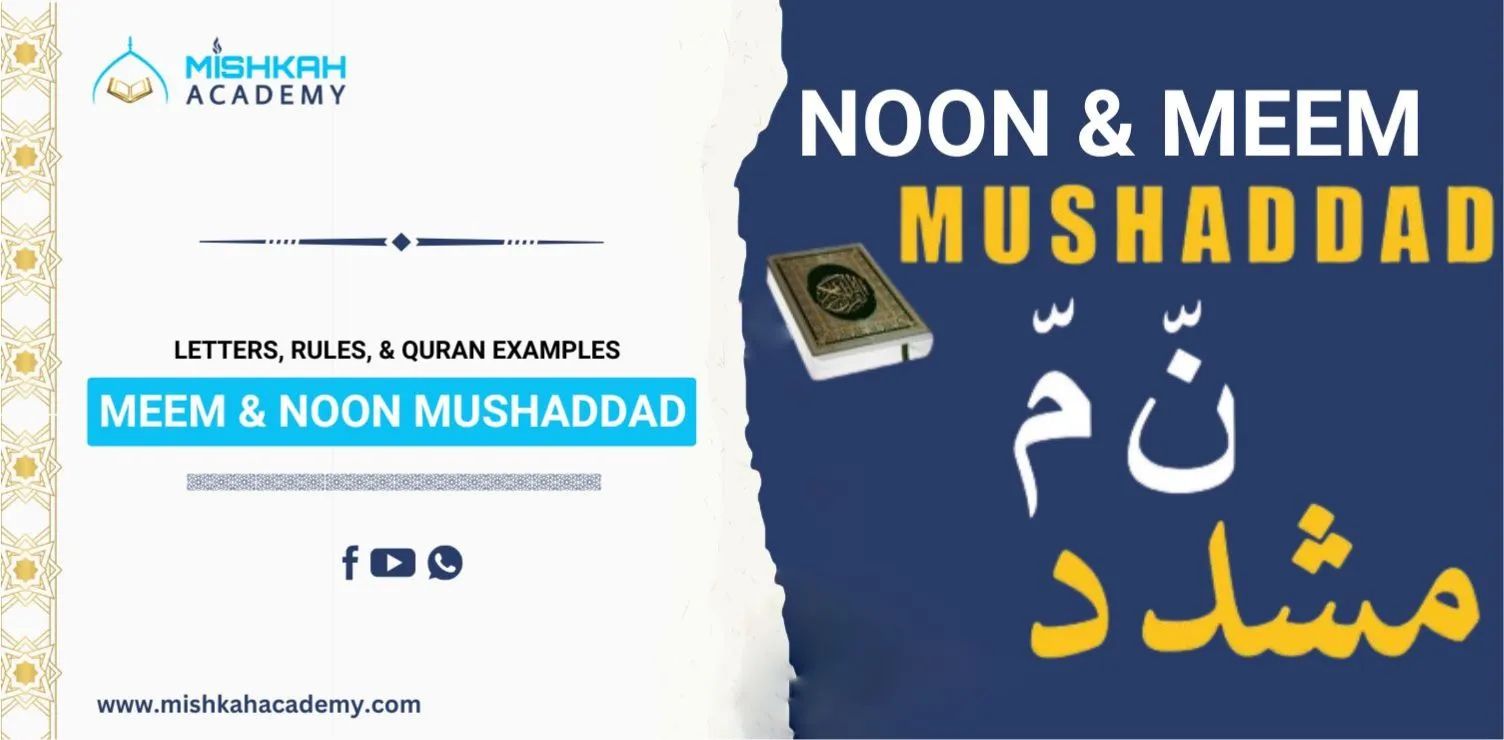What is Meem and Noon Mushaddad?
Table of Contents
ToggleAs the holiest word of Islam, the Quran is extremely important to Muslims all over the world. The correct pronunciation of its letters, which is regulated by Tajweed laws, is one of the most important parts of reciting it. The regulations pertaining to the letters meem mushaddad and noon mushaddad are among these basic guidelines. To guarantee the class, clarity, and clarity of Quranic recitation, these letters must be spoken according to clear rules.
Understanding Mushaddad Letters in Arabic
It is crucial to first understand what a mushaddad letter is in order to understand the regulations controlling meem mushaddad and noon mushaddad completely. The root word shaddah (ـّ), an Arabic diacritical mark, is where the word “mushaddad” originates. A letter should be pronounced with stress or doubling when this mark is present. Basically, a letter with a shaddah is written once but pronounced twice: a vowel is pronounced at the second occurrence, whereas the first occurrence is silent (sakin).
Examples
meem mushaddad (مّ) and noon mushaddad (ن) are the terms used when the letter meem (مّ) and noon mushaddad (نّ), is used with a shaddah (ـّ). When pronouncing these letters, extra emphasis is required. As will be covered in more detail below, ghunnah, or nasalization, is also required when reciting meem mushaddad and noon mushaddad.
Importance of Meem and Noon Mushaddad in Tajweed
The collection of guidelines that dictate how the Quran should be recited is known as Tajweed. It guarantees that the Prophet Muhammad (PBUH) taught the proper way to pronounce Allah’s words. When the letters meem and noon come with a shaddah, there are laws of Tajweed that apply especially to them. These are known as meem mushaddad and noon mushaddad.
Maintaining the sense of the words in the Quran is just as important as maintaining clarity when pronouncing these letters correctly. Every reciter should study and follow these Tajweed regulations since misunderstanding these letters can change the meaning of the poems.
Rules of Noon and Meem Mushaddad
Ghunnah, a nasal sound that lasts for two harakat (the time it takes to speak two vowel motions like “aa” or “oo”), is used to recite both noon mushaddad and meem mushaddad. The nasal sound is an important part of correct Quran recitation and cannot be removed or smaller.
-
Noon Mushaddad Rules
Ghunnah must be recited whenever the letter noon (ن) is used with a shaddah. For two harakat, the reciter should make a nasal sound. The sound, which is released by the nose, adds a lengthy, increased aspect to the noon.
Example 1: Surah Al-Qadr (97:1) – إِنَّا أَنزَلْنَاهُ فِي لَيْلَةِ الْقَدْرِ
In the word “إِنَّا“, the noon mushaddad is pronounced with a nasal sound for two harakat.
Example 2: Surah Al-Fatiha (1:7) – صِرَاطَ الَّذِينَ أَنْعَمْتَ عَلَيْهِمْ
The noon mushaddad in “أَنْعَمْتَ” is recited with ghunnah, ensuring proper emphasis and prolongation.
-
Meem Mushaddad Rules
In a similar vein, ghunnah for two harakat shall be recited whenever the letter meem (م) comes with a shaddah. As a labial letter, the meem is spoken with the lips and, in this instance, the sound is nasalized for the necessary amount of time.
Example 1: Surah Al-Fil (105:1) – أَلَمْ تَرَ كَيْفَ فَعَلَ رَبُّكَ بِأَصْحَابِ الْفِيلِ
In this verse, the word “رَبُّكَ” contains a meem mushaddad, requiring nasalization and emphasis on the meem.
Example 2: Surah Al-Masad (111:1) – تَبَّتْ يَدَا أَبِي لَهَبٍ وَتَبَّ
In the word “تَبَّتْ”, the meem mushaddad is pronounced with ghunnah.
Note: Enroll in the Advance tajweed course to learn all Meem and Noon Mushaddad rules with expert egyptian quran tutors.
Start Your Quran Journey NowMeem and Noon Mushaddad Examples from the Quran
Here are additional examples where meem mushaddad and noon mushaddad appear in the Quran:
Meem Mushaddad Examples
قُلْ هُوَ اللَّهُ أَحَدٌ
In this verse, the word “أَحَدٌ” contains a meem mushaddad.
فَجَعَلَهُمْ كَعَصْفٍ مَّأْكُولٍ
The meem mushaddad is in the word “مَّأْكُولٍ”, pronounced with ghunnah.
Noon Mushaddad Examples
اهْدِنَا الصِّرَاطَ الْمُسْتَقِيمَ
The noon mushaddad appears in “اهْدِنَا“, requiring nasalization.
إِنَّا أَنزَلْنَاهُ فِي لَيْلَةِ الْقَدْرِ
The word “إِنَّا“
Pronunciation of Meem and Noon Mushaddad
How to Pronounce Meem and Noon Mushaddad
Making a nasal sound with the nose and holding it for two harakat is how meem mushaddad and noon mushaddad are pronounced. Here’s a deeper look at the proper way to write each letter:
Meem Mushaddad Pronunciation
A distinct nasal sound should be used to prolong the meem mushaddad sound. When pronouncing the meem, the lips should meet and the sound should enter via the nasal canal. Since the ghunnah must last for two harakat, it is imperative that the reciter take their time making this sound.
Noon Mushaddad Pronunciation
The nasal sound is produced while the tongue touches the roof of the mouth close to the teeth when pronouncing the midday mushaddad. In order to ensure that the noon is recited with correct emphasis, the ghunnah should last for two harakat, just like the meem mushaddad.
The Role of Ghunnah in Reciting Meem and Noon Mushaddad
A vital component of the regulations governing meem and noon mushaddad is ghunnah. The nasalization of sound, known as ghunnah, is required while reciting both of these letters with a shaddah. The nasal cavity produces the nasal sound, and two harakat are used to quantify the ghunnah’s length. The proper use of ghunnah is crucial in Quranic recitation in order to guarantee that the recitation is both beautiful and complies with Tajweed guidelines.
Importance of Correct Pronunciation in Tajweed
It is impossible to underestimate the importance of properly applying the meem mushaddad and noon mushaddad rules. These guidelines are important for maintaining the message of the Quran; they are not just suggestions. Misunderstandings or misunderstandings in the meaning of the verses may result from mispronouncing these letters or from failing to apply ghunnah when it is necessary.
- Clarity of Meaning: The Quranic text’s meaning is guaranteed to stay intact and clear when it is pronounced correctly. Meaning can be significantly altered by even minor pronunciation mistakes.
- Beauty of Recitation: Meem and noon mushaddad are two of the Tajweed regulations that contribute to the Quran’s renownedly beautiful and rhythmic recitation. Recitors can improve the melody and flow of their recitation by correctly implementing the rules.
- Following to the Sunnah: The Prophet Muhammad (PBUH) stressed the need of accurately reciting the Quran. Following the Sunnah and maintaining the Quran in its unadulterated state can be done through understanding and putting into practice the norms of Tajweed, which include those connected with meem and noon mushaddad.
Conclusion
To sum up, meem mushaddad and noon mushaddad, which are defined by ghunnah, are crucial elements of Quranic recitation. These guidelines make sure the reciter stresses and nasalizes the letters meem and noon correctly, which improves the recitation’s clarity and beauty. The accuracy of the Quran’s message is maintained by comprehending these guidelines and practicing with passages from the text.
At Mishkah Academy, we offer online tajweed classes that help students understand and follow these guidelines when reciting the Quran. By doing this, we fulfill our responsibility to respect the veracity of Allah’s teachings and follow the Prophet Muhammad (PBUH).
Start Your Quran Journey Now





